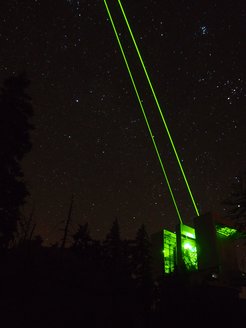First Laser Beacons with ARGOS
On 5 November 2013 the ARGOS laser system has been successfully tested on the sky for the first time. From behind the secondary mirrors of the Large Binocular Telescope (LBT), a bundle of laser beams was propagated into the night skies above Arizona.

The ARGOS project provides artificial guide stars that will be used to correct the distortions in astronomical images caused by atmospheric turbulence. Above each of the LBT mirrors (which have a diameter of 8.4 metres), the laser beams generate a constellation of bright laser guide stars by Rayleigh scattering within the Earth’s atmosphere. A total of six powerful, pulsed Neodym-YAG lasers deliver up to 18 W – three artificial laser beacons for each telescope of the LBT. The returning, scattered light in this geometry is particularly sensitive to air turbulences close to the ground. By measuring and correcting the optical distortions induced by these ground layers, ARGOS will achieve an image correction over a very wide field of view. The laser test performed at the beginning of November is the first step in a series of campaigns that will finally lead to image corrections with the adaptive secondary mirrors of the LBT. The completion and commissioning of this adaptive optics system will last into 2014 when astronomers will be able to use the fully operable ground layer adaptive optics facility.

Due to the wide-field corrections provided by ARGOS, the twin multi-object spectrographs Luci1 and Luci2 will be able to deliver much higher spatial resolution as well as a strongly enhanced flux in spectroscopy mode. This in turn will result in a major gain for a large number of scientific programmes.

With its ability to sharpen the images under almost any seeing condition over a large field of view, ARGOS will significantly shorten observation times and enable science observations that could not be carried out without laser guided adaptive optics. To pick just one example from the very wide range of scientific applications of this system, in future, the astronomers will be able to obtain simultaneous, spatially resolved spectroscopy of multiple galaxies at high redshift, allowing deep insights into the process of galaxy evolution in the early universe.
ARGOS is a MPE-led project with the LBT partner institutes: MPE, MPIA, LSW, AIP and MPIfR in Germany, INAF Arcetri in Italy and UoA in the USA.














